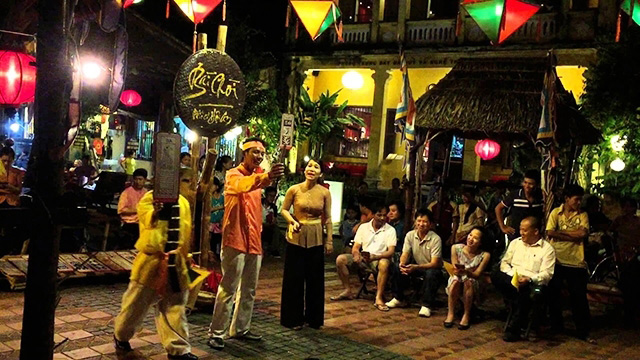


|
A performance of Bai choi singing in ancient Hoi An city, Quang Nam province UNESCO recognition for the
two art forms not only honours Vietnam’s unique culture but also secures
effective preservation and promotion of the country’s heritages.
Bai choi singing: From folk entertainment to the
professional stage
Bai choi, a diverse art form combining music, poetry,
acting, painting, and literature, is an important and indispensable spiritual
and cultural practice for people from the south central region of Vietnam
over past centuries. Dated to the end of the 19th century and the early 20th
century, the art form has been kept alive through music, lyrics, and acting.
Starting from a type of
work song performed for entertainment among farmers on the fields during
their time keeping watch for wild animals who damage their crops, Bai
choi has developed into two main forms Bai choi games,
which is a card game played in bamboo huts under the instruction of male and
female Hieu artists, and Bai choi performances.
Traditionally, Hieu
artists, who lead the game, only read short lines, but as the art form has
developed, they now read 10 to 20 sentence-long lines, narrate extracts from
folktales of specific characters, events and happenings as well as extracts
of popular Tuong (classical drama) pieces. They also perform
quite a lot of stage acting to help audiences navigate the characters and the
background of each scene in the story.
Bai choi art troupes were first established in the
south central region during the national anti-France resistance war, which
laid the foundation for the art form to reach professionalism after that. The
first professional Bai choi troupe was formed in 1957 under
the decision of the Ministry of Culture (now the Ministry of Culture, Sports,
and Tourism).
Since the country’s
reunification in 1975, only three professional Bai choi art
troupes from three provinces of Binh Dinh, Quang Nam, and Khanh Hoa have
proven their continued and effective operation, delivering regular
performances to audiences. There are also amateur Bai choi art
troupes in other localities throughout the region, which attract enthusiastic
participation of local residents and are greatly appreciated by audiences.
The art of Bai choi not
only serves as a form of entertainment but also provides an environment for
social interactions among the community, drawing participation from people of
all walks of life.
Thanks to researchers and
efforts made in the preservation and promotion of the heritage’s value, as
well as supports provided by leaders of the cultural sector and local
authorities, and the admiration of the audience, Bai choi singing
has embraced pressures and challenges posed by market mechanisms and
commercialisation to win UNESCO status as an Intangible Cultural Heritage of
Humanity.
This accolade illustrates
UNESCO’s recognition of the efforts and passion of Bai choi artists,
as well as the positive involvement of the cultural sector and local
authorities.
Reward for efforts to
save Xoan singing
Soon after Bai choi singing
won the UNESCO honour, Xoan singing, a folk music genre in
Vietnam’s northern midland province of Phu Tho, was removed from UNESCO’s
List of Intangible Cultural Heritage in Need of Urgent Safeguarding and added
to the Representative List of the Intangible Cultural Heritage of Humanity.
It was a reward for six
years of strict implementation of Vietnam’s commitments to UNESCO on
safeguarding, promoting and reviving the art form in its community.
In 2011, Xoan singing
was recognised by UNESCO as being in need of urgent protection. At that time,
there were roughly just 100 practitioners of Xoan singing,
more than half of whom were over 60, and only seven out of over-80-year-old
practitioners were capable of teaching more locals.
But today, Xoan singing
is practiced in four original guilds and local Xoan singing
clubs have been set up in hamlets in Phu Tho province, which have more than
1,900 members in total, increasing by dozens as compared to six years ago. In
addition, 42 similar clubs have also been established in communes throughout
the province, with a total of more than 1,300 members.
Xoan singing has also been taught to
schoolchildren, as every school in the province, from kindergartens to
primary, secondary, and high schools give their students the opportunity to
learn about the singing in music class or through extracurricular activities.
The local authorities have
paid attention to honouring outstanding Xoan practitioners,
restoring the temples where Xoan singing is usually
performed. A concerted effort, with the involvement of authorities at all
levels and organisations, has been made to bring the heritage closer to the
community.
UNESCO recognition for ‘Bai
choi’ and ‘Xoan’ singing is a deserving reward for the huge
efforts to preserve and promote heritage value and the assistance from the
Ministry of Culture, Sports and Tourism, Vietnam National Commission for
UNESCO, and research institutes.
With the addition of the
two art forms, Vietnam now has a total of 11 elements of Intangible Cultural
Heritage of Humanity which have been recognised by the UN’s cultural agency.
UNESCO acknowledgement for
the 11 heritages will contribute to advertising and affirming Vietnamese
cultural essence. It also demonstrates Vietnam’s commitment to safeguarding
the cultural heritage of humanity in respect of cultural diversity while
encouraging dialogues among individuals, communities, and ethnic groups in
order to facilitate love, compassion, and tolerance, in accordance with
UNESCO’s goals and objectives.
|
Source: NDO